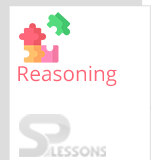 Introduction
Introduction
Logical Reasoning is an important section in the Competitive Exams throughout the globe. Logical reasoning is primarily designed to test the aptitude skills of the candidates taking the exams. Cubes and Dice related questions are frequently seen in several competitive exams including recruitment exams in India such as SSC CGL, Banking, Railways, and other exams such as CAT, GRE, GMAT, etc. The article Cubes and Dice Practice Quiz 2 lists some practice questions that will apply different concepts of cubes and dice.
What is a Dice?
A Dice is a Cube. A cube has 6 squares faces/sides and 8 vertices/corners, and 12 edges. Only 3 sides of a cube are visible at any given time. These sides are known as adjacent sides and can never be to the opposite side of each other. A Dice usually has numbers labelled 1 to 6.
 Quiz
Quiz
1. Observe the dots on a dice (one to six dots) in the following figures. How many dots are contained on the face opposite to that containing four dots?
- A. 2
B. 3
C. 5
D. Cannot be determined
- A. 1
B. 3
C. 5
D. 6
- A. C
B. D
C. E
D. F
- A. 6
B. 5
C. 3
D. 1
- A. 3
B. 4
C. 5
D. 6
1. Two positions of a dice are shown. When 4 is at the bottom, what number will be on the top?
- A. 1
B. 2
C. 5
D. 6
- A. 1
B. 5
C. 6
D. Cannot be determined
- A. 2
B. 3
C. 4
D. 6
- A. 1
B. 4
C. 5
D. 6
- A. 4 is adjacent to 6
B. 2 is adjacent to 5
C. 1 is adjacent to 6
D. 1 is adjacent to 4
Direction [1 - 5] : The sheet of paper shown in the figure (X) given on the left hand side, in each problem, is folded to form a box. Choose from amongst the alternatives (1), (2), (3) and (4), the boxes that are similar to the box that will be formed.
1. Choose the box that is similar to the box formed from the given sheet of paper (X).
- A. 1 and 2 only
B. 2 and 4 only
C. 2 and 3 only
D. 1 and 4 only
- A. 1 and 4 only
B. 3 and 4 only
C. 1 and 2 only
D. 2 and 3 only
- A. 2
B. 4
C. 5
D. 6
- A. 1 and 3 only
B. 1 and 4 only
C. 2 and 4 only
D. 3 and 4 only
- A. 1 and 2 only
B. 2 and 3 only
C. 2 and 4 only
D. 1, 2, 3 and 4
Other Articles
 Study Guide
Study Guide
 Exams
Exams
| Competitive Exams - College Entrance Exams | |||
|---|---|---|---|
| Category | Notification | ||
| Diploma | NITC New Delhi | Goa Diploma Admissions 2019 | |
| Click Here For – All India Entrance Exam Notifications | |||
 Daily CA
Daily CA
 Job-Alerts
Job-Alerts
 SP Quiz
SP Quiz
| Competitive Exams - Practice Sets | |
|---|---|
| Category | Quiz |
| Quant Aptitude | Permutation and Combination |
| Reasoning Ability | Direction Sense |
| Current Affairs | Current Affairs |
 GK
GK
| General Knowledge for Competitive Examinations | |
|---|---|
| Topic | Name of the Article |
| GK - World | Highest Civilian Awards |
| Important Newspapers | |
| World Seaports | |
| GK - India | Union Budget 2019 – Interim Budget |
| Economic Survey Highlights 2018-2019 | |
| Indian Chief of Army Staff | |
| GK - Abbreviations | Banking Abbreviations & Finance Abbreviations |
| International Organizations Abbreviations | |
| GK - Banking & Insurance | Merchant Banking Services |
| National Housing Bank | |
| GK - Science & Technology | Scientific Laws and Theories |
| Important Scientific Instruments | |
| Father of Different Fields – Science & Technology | |

















